Ten years ago – just as I was turning 30 – I decided that I wanted to get to space, and I set myself the challenge of doing so before I was 40.
At the time, there was huge excitement about the dawn of commercial spaceflight, companies like Virgin Galactic, SpaceX, XCOR and Blue Origin promised to change access to space – be it orbital or sub-orbital.
Getting myself to space was always going to be a huge challenge – nigh on impossible – but that had never stopped me before. Technically it seemed improbable, but not truly impossible.
I had a hare-brained scheme involving stories, luck, outreach and Richard Branson. Oh, and MILLIONS of Virgin airmiles. I’d even got the film in mind – where I narrowly missed out on getting enough airmiles by the deadline, and then Branson got to play the hero and put me on a flight anyway.

At the time, my friends were getting married, having children, getting promoted, putting deposits on their first homes – you know - growing up. I on the other hand had basically regressed to the childish optimism of a seven year-old, announcing that I wanted to be an astronaut.
So here we are – a decade later and I’ve just turned forty – did I complete my challenge and get to space? Well… no.
Mission failure?
Does that mean mission failure? I’ll let you decide, but here are a (just a few) highlights of the past decade:
- I had lunch with an astronaut.
- I saw a space shuttle launch – STS-133 – the final flight of space shuttle Discovery.
- I made friends with the most wonderful group of space fans during the 115 day delay to the launch of Discovery – and accidentally swapped a 10 day trip to the US to a four month “SpaceNomad” adventure.
- Thanks to a chance encounter with the (then) NASA Administrator, I got to see Discovery land for the final time. Pinch me.
- I went to the Mojave desert on a NASA Spaceward Bound trip with astrobiologist Dr Chris McKay (admittedly this was slightly prior to bringing my @SpaceKate alter-ego to life).
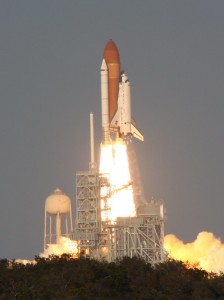 I saw my first rocket launch in person – a SpaceX Falcon9 with the Dragon capsule – and a wheel of cheese.
I saw my first rocket launch in person – a SpaceX Falcon9 with the Dragon capsule – and a wheel of cheese.- I visited Kennedy Space Center, NASA Ames, Johnson Space Center and NASA HQ.
- I’ve made friends with rockets scientists, mission controllers, flight surgeons, astronauts and cosmonauts!
- I’ve attended multiple NASA social events and the first ever ESA ‘Social Space’ event.
- I’ve visited the astronaut training centre in Cologne and the Neutral Buoyancy Lab in Houston.
- I’ve made friends with two of the crew members of the Mars500 experiment – and done a road trip across America with one of them (despite not being able to drive!).
- I attended the International Space University Space Studies Programme and got to walk underneath a space shuttle in the orbiter processing facility at KSC.
- I’ve watched as friends from the STS-133 tweet-up family got jobs in the space industry (I’m so proud of you!).
- I’ve written for the UK Space Agency magazine.
- I got to see Mars Curiosity land on Mars – from JPL!
- I was given the Canadian Space Agency pin by the head of the agency – he took it off his jacket for me!
- I saw the ATV dock with the space station from the control centre in Toulouse – and then talked about it on BBC radio.
- I watched space shuttle Endeavour roll out to the pad for the final time – the enormity of the crawler is hard to describe.
- I went to “Endless BBQs”, drunk ‘von Braun brown ale” at the Cocoa Beach Brewing Company, and been made to feel part of the family.
- I’ve written papers and presented them at international space conferences.
- I’ve spoken about women in space at the Royal Aeronautical Society.
- I saw the final shuttle launch, and landing, (and got eaten by mosquitoes in the procoess).
- I joined the British Interplanetary Society and have written for their magazine – Spaceflight.
- I made friends with Chris Hadfield and can confirm that his suggestion to have coffee and beignets at Cafe du Monde in New Orleans is a “must do”- I was on his ‘friends and family’ list when he was in space and got to email him while he was Commander. (I also missed a phone call from the ISS – but have the BEST voicemail message ever).
- I made friends with cosmonaut Anton Shkaplerov – who became the talk of Saltdean when he passed his greetings to my grandmother, who then enjoyed telling people “I’m nearly 90, and I’ve got a friend in space”.
- I went to SpaceUp San Diego at the invite of the organiser, then SpaceUP:EU, and finally made SpaceUP:UK happen for the first time.
- I sat in a Soyuz capsule – and separately, was told by the head of the cosmonaut office, that I was a good size for the Soyuz.
- I visited SpaceX – so shiny!
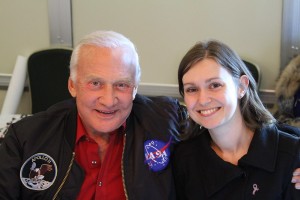 I met Buzz Aldrin – and over-excitedly exclaimed “You walked on the Moon”.
I met Buzz Aldrin – and over-excitedly exclaimed “You walked on the Moon”.- I made friends with Charlie Duke – 10th man to walk on the Moon.
- I got fashion advice from space.
- I worked for a company that was aiming for the Moon.
- I learned that there is a lot of “hot-air” and over-optimistic talk in the new-space industry.
- I went to watch aurora and walked on a frozen river.
- I embarrassed myself by asking Apollo 13′s Jim Lovell about the “dark” side of the Moon, and having been corrected – “you mean far side” – will never make that mistake again.
- I explained on live radio that there isn’t a place where you can “turn off gravity” to train for spaceflight, and that even in orbit you are subject to the force of gravity – you’re just falling fast enough to keep missing the ground.
- I’ve collected space patches, autographs, stickers and a cuddly Rosetta – and always try to have something that I can pass on to an excited kid (big or small) to make space “real” for them.
- I’ve ended up with more followers on my @SpaceKate Twitter than my original @RadioKate account!
- I’ve been able to talk about space on Sky News and on the BBC World Service programme “Digital Planet”, among others.
- I’ve fought against sexism in space and worked hard to make space more accessible for people from different backgrounds.
- I’ve been on the Zero-G plane twice – but never when it’s taken off!
- I’ve visited Goonhilly Earth station and bounced my voice off the Moon!
- I’ve discovered new music, art and craft – all related to space.
- I learned that fireworks are illegal in parts of Florida – but firing Estes rockets is totally fine(!!)
- I’ve walked with cosmonauts, had dinner with astronauts – even been advised on the best way to tackle a large multi-course Italian meal by Cady Coleman!
- I’ve met both British astronauts and attempted to be the third.
- I’ve been part of the Space Generation Advisory Council – was UK point of contact for them – and I’m on the advisory board of For All Moonkind.
- I’ve campaigned to replace non-inclusive/troubling language such as “manned” and “colonise”.
- I’ve won the NASA International Space Apps Challenge – twice in London, and once internationally!
- I’ve frequently thought about doing a PhD or training as a space lawyer or policy advisor – and wished that astrobiology had been an option when I did my undergrad degree.
- I’ve done my best to share – to “make it real” – to bring people along on my adventures – and encourage more people to consider the space sector as a place to work.
- I reported on the first human space launch from the US since the end of the shuttle programme.
That’s just a taste of the most unbelievably, unexpectedly awesome, decade of space adventures that I’ve had.
Commercial hype?
But what about the options for getting to space? When I started out, the space shuttle was retiring, Soyuz going strong, and I had a bet with a friend about when SpaceX (or any American organisation) would next fly people to space from the US (I won).
Virgin Galactic had a disaster which cost the life of one of their test pilots, but in 2019 managed a test-flight that took their Chief Astronaut Trainer Beth Moses to space as well as the test pilots. The COVID pandemic has been given as the reason for moving commercial passenger flights – including one for Branson himself – to next year. In other words – even if my mad plan had got off the ground, I would not have. (And yes – I did once offer myself as “ballast” for a test flight.)
XCOR with their Lynx spacecraft are sadly no more.
SpaceX just managed to squeeze a crewed flight to the ISS in just before my birthday, but once again that was a demo flight, to open the door for NASA flights to the ISS to go ahead. There would have be no way as a commercial customer to make it on to that flight.
Boeing has been having some issues with Starliner, so it will be a while before they carry humans to space, and Blue Origin, who are quietly squirreling away in the background are probably doing some exciting stuff, but there’s no chance of getting to space with them just yet either.
That means the only options for getting to space in the last decade were:
- paying MILLIONS and going on Soyuz – not easy, not technically impossible for someone, definitely impossible for me
- somehow persuading the Chinese to have sent me on one of their three crewed missions since 2010 (2012, 2013 and 2016) – definitely impossible for me
- becoming an ESA astronaut and getting assigned to a mission – impossible, since there hasn’t been an ESA astronaut selection call in that time
- marry an American, apply to be an astronaut, get trained, get selected for a mission – um…
Space?
So have I been to space? Physically, no. But… my photo and voice have been on the ISS, my voice has been to the Moon and back, and my signature sent to Mars.
Would it have been possible for me to get to space in the past decade? Without multi-millions to hand – no.
The friends I’ve made, the places I’ve seen, the adventures I’ve had… the kindness and encouragement that people have shown me, and the doors they have opened – special shout-out to Charlie Bolden – I have been so lucky. I’ll never forget, and never stop sharing as much as I can to others who haven’t been as lucky, or had the opportunities that I have.
Was commercial spaceflight hyped too much a decade ago? Perhaps. My mission seemed “improbable”, but not “impossible” when I first set out – but as you can see, “impossible” turned out to be the case really. I do hope that sometime within in my lifetime there will be a chance for ‘normal’ people like me to experience spaceflight – and maybe I will try to get on a Zero-G flight before I’m fifty at least. (Hint hint!)
It’s an exciting sector, there are more stories to be told, and there are some great people in the space family. Getting to be a part of it has been the honour of it life. Ad astra my friends.
 If you know me (and even if you don’t) it’s pretty obvious that I like rocket launches, which is why today, 27th May, 2020 is an exciting day. If the weather cooperates, we’ll see the first commercial crew flight – with astronauts on board – to the International Space Station (ISS), and it’s launching at 4.33pm EDT (9.33pm BST).
If you know me (and even if you don’t) it’s pretty obvious that I like rocket launches, which is why today, 27th May, 2020 is an exciting day. If the weather cooperates, we’ll see the first commercial crew flight – with astronauts on board – to the International Space Station (ISS), and it’s launching at 4.33pm EDT (9.33pm BST).
What’s so special about that – astronauts go to space all the time don’t they?
Apart from the fact that rocket launches are cool, there are several elements of this mission that mean it’s a big deal for the space community – especially those in the USA. For the last nine years, every astronaut and cosmonaut to have flown to the ISS has flown on a Russian Soyuz rocket, launching from Kazakhstan (roughly every three months). Soyuz has been the only human-rated vehicle capable of reaching, and docking with, the space station – meaning if anything ever stopped Soyuz flying (as happened in November 2018) it could mean serious problems (including, potentially, an early end to the ISS programme). Today’s Demo Mission 2 (DM-2) launch also includes a number of “firsts”:
- This will be the first time since the space shuttle programme ended, that the US has launched astronauts to the ISS, on a US rocket, from US soil – and that was nine years ago, in 2011. Many in the US have been waiting for this moment for a long time, and felt the gap in US human launch capability, was too long. (In fact in December 2010 I placed a bet with a friend of mine about when the US would next send it’s own astronauts into space post-Shuttle programme… happily/sadly I won!)
- This will also be the first time that the SpaceX Falcon 9 and the Crew Dragon capsule will be used to launch humans into space. We know that space is hard, and with human lives at stake, there is very little room for error. Of course the rocket and the capsule have both gone through significant testing programmes and wouldn’t be allowed to fly without NASA sign-off, but any launch carries a risk, and this has never been done before. Now as much as you might imagine astronauts to be super-human, they are just people, highly trained people, sitting on top of a lot of rocket fuel.
- This is also the first flight where NASA has “bought a ride” with a commercial operator to send humans to the ISS. When the space shuttle was retired, the idea was that rather than have NASA spend its money developing another vehicle to reach low Earth orbit, which it knows it can do, perhaps they should concentrate on pushing the boundaries and exploring further. Funding was given to commercial space companies to develop cargo- and crew-transport vehicles, so NASA could use commercial services to support the ISS. It likened to a using a taxi service rather than owning your own car.
When is it happening?
The launch is scheduled for 4.33 pm EDT – which equates to 9.33pm BST. It is an “instantaneous launch window”, meaning that if there is any hold up at all they will have to try again in the next available launch window, which would be either 30th or 31st May. The reason they can’t launch at any old time is that they have to time the launch to match with the position of the space station (which is orbiting the planet at approx.. 17,500 mph!) in such a way that their rocket can basically chase, and catch-up with, the ISS ready for docking. You don’t want to risk crashing into the ISS, and nor do you want to be so far away you run out of fuel before you catch-up with it!
How can I watch?
With COVID-19 social distancing rules in place, even if you’re lucky enough to be on the space coast near Cape Canaveral, you should really stay home and stay safe. For those of us watching from around the globe, you’ll find livestreams available online on NASA TV which begins its official launch programming at 12.15pm EDT (5.15pm BST) and also on the SpaceX website at the same time (I’m not clear if SpaceX will run the same content as NASA or create their own coverage). If you’re in the UK, its ISS-spotting season, so if you wanted to tear yourself away from the launch coverage between 21:20 and 21:27 depending on how dark it is, you might just about be able to catch the ISS overhead. Else just wait for the next pass just before 11pm, although this won’t be so high in the sky, so it depends on how clear your horizon is. Excitingly, because the Crew Dragon is chasing the ISS, it will also pass over the UK – so if you’re able to, pop outside and look to the south-west and try to spot it at 21:53! It won’t be anything like as bright as some of the good ISS passes are, but how awesome would it be to watch a launch online, and 20 minutes later watch that same vehicle fly over your house? Here’s hoping for clear skies! You can find out when to look out for the ISS and Crew Dragon with the amazing (if basic looking) Heavens Above website.
Who is onboard?
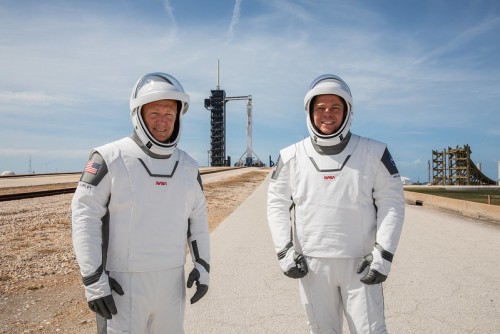
NASA astronauts Douglas Hurley (left) and Robert Behnken (right) ahead of their historic commercial crew programme launch. Credit: NASA/Kim Shiflett
Two astronauts are going to be onboard Crew Dragon for this flight (though it has the capacity of four crew members for NASA missions, and up to seven according to SpaceX) and they are NASA spaceflight veterans Robert Behnken and Douglas Hurley (who piloted the final space shuttle flight back in 2011). They will join the ISS Expedition 63 crew on the space station – for an as-yet undecided – stay (though the Demo-2 capsule has a 110 day on-orbit limit).
How can I find out more?
Check out the “Launch America” pages on the NASA website and find out more about Crew Dragon and Falcon 9 on the SpaceX website. Space social media is already a-buzz with people discussing the missions and getting excited to watch the launch today. The #LaunchAmerica hashtag is being promoted by NASA, but you’ll find plenty of people using #SpaceX #DM2 (Demo Mission 2) #CrewDragon and more. I like to tweet about #LaunchClub and find out where in the world people are watching – launches like this always attract a big international audience, which is awesome. As is traditional, I’ll say “God speed” Crew Dragon, Bob and Doug, may you have soft landings (does that count for splashdowns?), and I’ll see you all later this evening, tweeting frantically as @SpaceKate!
Events Getting to space News Q&A by .
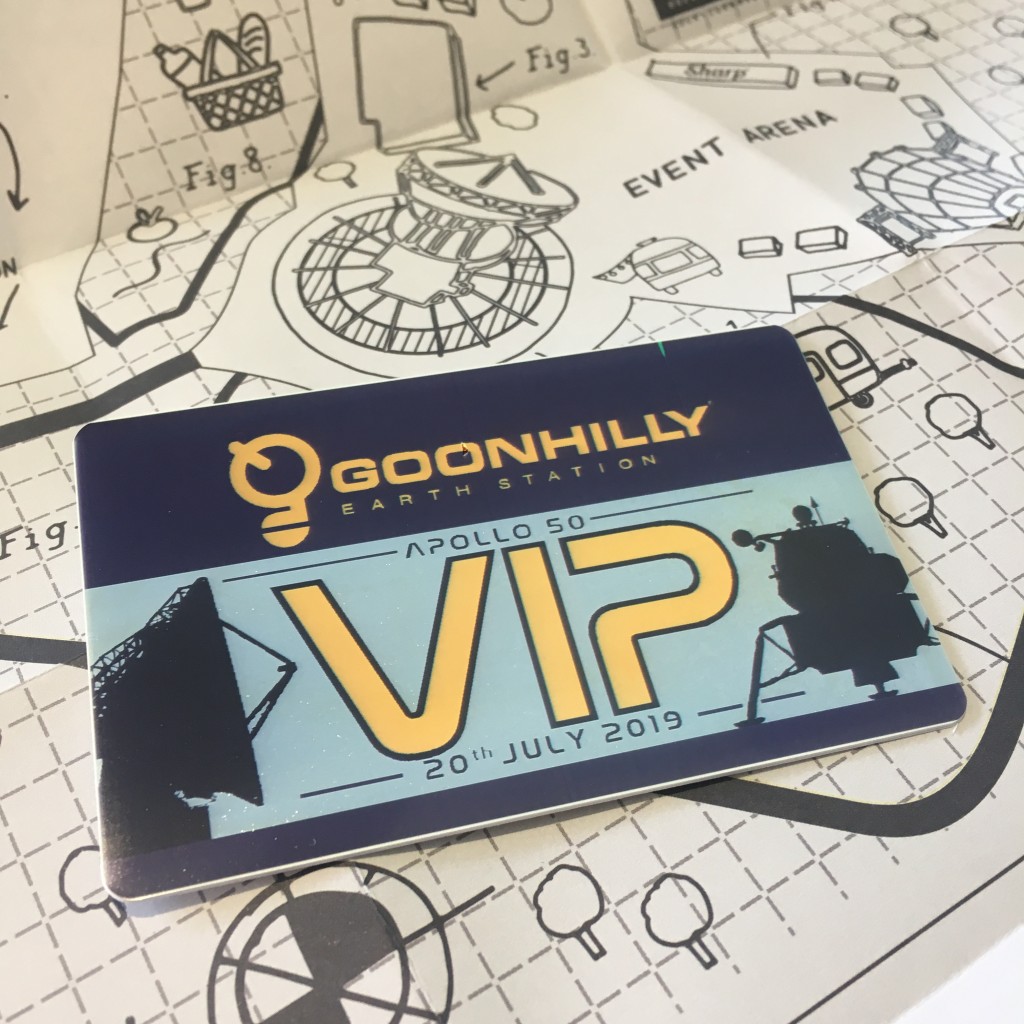
The 50th anniversary of the first human footsteps on the Moon seemed like a good thing to celebrate, and without the time/budget to make it to the US, I needed to find a celebration a little closer to home. What better place than Goonhilly Earth Station down in Cornwall for a day of space, music, author talks beer and even a quiz?
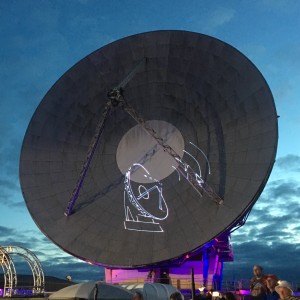
“Arthur” the dish that received the first live transatlantic TV broadcasts was the backdrop to the Apollo50 event, with a cool laser display!
Surrounded by large dishes, some in the process of being restored and upgraded to become ground stations (potentially for future Moon missions), we had a fabulous day. It’s amazing to think that when Ian Jones and his small team decided to rescue the Goonhilly site and bring it back to life as a commercial ground station there were trees growing through some of the dishes! It was great to see what they’ve got up and running already and hear plans for the future – and then there was Public Service Broadcasting, banging out some of their excellent space-based tunes from the Race to Space album. What more could you want?
 Well it was a sunny day – so how about a pint of “One Giant Leap” beer? Described as an IPA – Inter-Planetary Ale – it was brewed specially for the event by Sharp’s (a well-known Cornish brewery) and even used space-themed ingredients such as planet malt, and aurora and galaxy hops! They’d done an excellent job of designing the beer tap markers too.
Well it was a sunny day – so how about a pint of “One Giant Leap” beer? Described as an IPA – Inter-Planetary Ale – it was brewed specially for the event by Sharp’s (a well-known Cornish brewery) and even used space-themed ingredients such as planet malt, and aurora and galaxy hops! They’d done an excellent job of designing the beer tap markers too.
With the Radiophonic Workshop playing bits from Hitchhiker’s Guide and the Doctor Who theme compilation it was a geeky paradise!

The pièce de résistance was yet to come though – a live Moon bounce (where you transmit a signal to the Moon and literally use the surface of the Moon as a giant reflector and pick it up again two seconds later) showed off what the Goonhilly facility is capable of. A chap even proposed to his girlfriend in front of the crowds, but the most wonderful bit for me was when they sent up clips of Neil Armstrong’s first words as he stepped off the ladder and on to the Moon back in 1969. This allowed us to hear his original iconic words, from the Moon, and that was a bit special. You can check out the video of that on my Instagram page!
Seven years ago, half way through my #SpaceNomad adventure waiting for STS-133 to launch, I found myself in a bar in Portland, Oregon.
With me, a good friend – and fellow space fan – James. James and I first met in the Netherlands at a new media conference, cemented a friendship in London, and then a promotion at work saw him heading back to the US to live in California. Home for James though, was Oregon, and here I was, unexpectedly in his town, meeting him for a glass of wine.
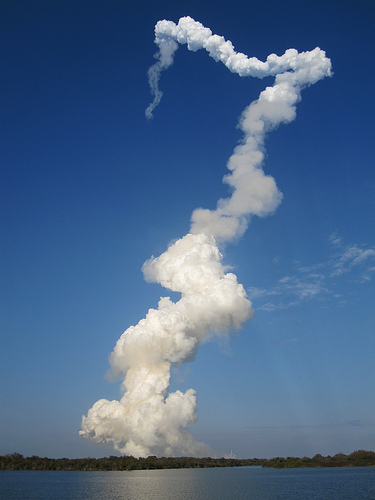 As we discussed the ending of the Space Shuttle programme I expressed the view that it would take quite some time for the US to be able to send astronauts back to space on their own hardware, but James was much more optimistic about companies like SpaceX filling the gap that shuttle would leave.
As we discussed the ending of the Space Shuttle programme I expressed the view that it would take quite some time for the US to be able to send astronauts back to space on their own hardware, but James was much more optimistic about companies like SpaceX filling the gap that shuttle would leave.
My network seemed to think it would be at least seven years before the US would fly their own astronauts, so I plumped for that as a reasonable estimate. James put his faith in the innovative spirit of Elon Musk and said they’d be flying before that. There was only one thing for it – a bet! (I mean, if it’s good enough for Stephen Hawking…)
I said the US wouldn’t have the capability to put people into space before 1st December 2017, and James took the opposing view. Having shaken on the deal – agreeing that whichever one lost the bet would have to cook the meal of the other’s choice, in the location of their choice (choosing between our two home towns) – I realised that much of my intel had been collected at the start of 2010. Had I made a mistake agreeing to December? It could be a close one! I took solace in the fact that at least I was betting on something that I’d be happy to see happen sooner, so even losing the bet would be positive.
Over the years we’ve sent emails back and forth, taunting each other with leaps in progress, or technical setbacks and delays. Each year my phone has reminded me on this day that the best was still running, but today I realise it’s over – I won!
Other than looking forward to conjuring up a tasty meal for James to cook – and wondering if he’ll really fly me to San Francisco so I can enjoy it! – I don’t feel much joy at having been right. This feels like a bet that I should have lost, and would have been happy to have lost, but space is hard and when it comes to human safety you don’t want to rush things.
I don’t like to think of myself as a cynic, I’m honestly an optimist at heart, but I also have a realistic view not only about what’s possible, but what is “likely” – and the too can sometimes be very different beasts.
Ad astra friends – and James… I’ll be in touch! ![]()
SpaceNomad by .


